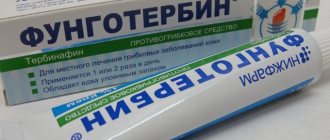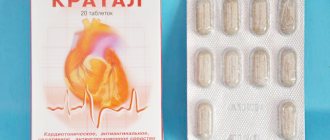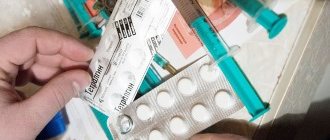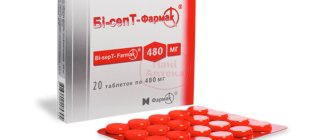Write a review
Reviews: 0
Manufacturers: Astellas Pharma Europe BV, Temmler Italia SrL (Italy)
Active ingredients
- Hydrocortisone
- Natamycin
Disease class
- Local infection of skin and subcutaneous tissue, unspecified
- Infectious dermatitis
Clinical and pharmacological group
- Not indicated. See instructions
Pharmacological action
- Antifungal topical
- Anti-inflammatory local
- Antibacterial
Pharmacological group
- Glucocorticoids in combinations
Compound
The amount of biologically active components does not change at all depending on the form of release of the pharmaceutical product. In both cream and ointment, the basic ratio is maintained:
- natamycin – 10 mg;
- neomycin sulfate – 3500 units;
- micronized hydrocortisone - 10 mg.
What really distinguishes the variations in release forms to a significant extent are the excipients, there are many more of them in the cream, which indicates a more selective action of the drug. This creates a harmonious background for the active components:
- F-emulsifier – 115 mg;
- cethiol V 150;
- cetyl ether wax – 60 mg;
- sorbitan stearate – 30 mg;
- macrogol stearate 100 – 20 mg;
- sodium citrate – 14 mg;
- methyl parahydroxybenzoate – 2 mg;
- propyl parahydroxybenzoate – 0.5 mg;
- purified water – up to 1000 mg.
The excipient of the ointment is only the ointment base in the amount of 976.5 mg (in mass fractions it contains 95 percent paraffin and 5 percent PE).
Release form
Pimafucort is available in two dosage forms:
- Cream, 1 g of which contains 3500 units of neomycin and 10 mg of natamycin and hydrocortisone. The cream is packaged in aluminum or plastic tubes of 15 or 30 g. For the most distrustful patients who think that insidious pharmacy workers shamelessly use the drugs they sell, the tube is equipped with an aluminum membrane. Along with the tube, instructions for Pimafucort are included in a cardboard box;
- An ointment that has the same quantitative composition of pharmacologically active components as the cream and exactly the same type of packaging and packaging, including an aluminum membrane on the tube and instructions for Pimafucort.
The manufacturer of Pimafucort is Italian, and final control is carried out by the Dutch pharmaceutical concern Astellas Pharma Europe, which is also the holder of the registration certificate for the drug.
Pharmacological action
Pimafucort is a complex pharmaceutical drug, because at the same time the drug has antibacterial, anti-inflammatory and antifungal effects . Due to the presence of such an active component as neomycin sulfate , which has antibiotic properties, the medicine can help even in cases of infection with gram-negative microorganisms, for example, Proteus, Klebsiella or Escherichia . Gram-positive bacteria, such as staphylococci or enterococci , also respond well to treatment with Pimafucort.
Natamycin, another active ingredient of the drug, belongs to the pharmaceutical group of macrolides , a subgroup of synthetic polyenes, that is, like Neomycin, it is an antibiotic in nature. However, Natamycin is more active against yeast and yeast-like fungi and dermatophytes. With the help of this component, you can defeat such families of microorganisms as Candida, Aspergilus, Trichophyton and others. Natamycin is also active against protozoa, for example, Trichomonas and Fusarium .
Hydrocortisone completes the trio of active ingredients of the drug. This is a hormone, therefore its range of therapeutic effects is the widest:
- reduces the sensation of itching ;
- reduces the manifestations of inflammation in pathologies of the skin (especially hyperthermia and hyperemia);
- inhibits hypersensitivity reactions;
- suppresses active processes of alteration , exudation and proliferation ;
- prevents activation of phospholipase A2 , thus stopping the synthesis of prostaglandins and the release of macrophage chemotactic factor;
- inhibits the activity of hyaluronidase ;
- blocks the synthesis and release of sensitized baso0 and eosinophils;
- suppresses various stages of the local immune process without having a mitostatic effect .
Therefore, the question “Is Pimafucort hormonal or not?” should not stand, because the drug actually contains active micronized Hydrocortisone , which is an active endogenous hormone of the adrenal glands. However, contrary to stereotypical and unfounded rumors and fears, it is the hormonal basis that creates the diversity of the therapeutic effect of a pharmaceutical drug, which is observed during the conservative course of treatment of various diseases.
Pharmacodynamics and pharmacokinetics
The pharmaceutical drug has a low adsorptive threshold on intact skin, that is, the active components are practically not absorbed into the body unless the condition requires it (the bioavailability of hydrocortisone is about 1-3 percent). However, when applied to wound defects (scratches, abrasions, ulcers, etc.) or mucous membranes, Pimafucort’s ability to be absorbed increases several times. Thus, eczematous lesions absorb 2 times better than undamaged areas, and infectious lesions – 4 times better.
Pharmacological authorities
Pharmacodynamics.
Pimafucort® is a combination drug that contains two drugs: hydrocortisone, neomycin and natamycin.
Hydrocortisone is a corticosteroid that has anti-inflammatory and anti-inflammatory effects. Hydrocortisone suppresses the inflammatory reaction and reduces the severity of symptoms of various skin diseases that often cause itching, but does not relieve the disease that was the cause of it.
Neomycin is a broad-spectrum antibiotic, active against both gram-positive (staphylococci, enterococci) and gram-negative ( Klebsiella spp., Proteus spp., Escherichia coli
) bacteria.
Pseudomonas aeruginosa
is resistant to neomycin
in vitro
.
Natamycin is combined with polyene antibiotics of the macrolide group and has a fungicidal effect against infections caused by fungi, including Candida spp.
. It is unknown whether other types of mushrooms are resistant to natamycin.
Cross-resistance between neomycin and other antibiotics of the aminoglycoside group can occur through the development of plasmids, enzymes that deactivate aminoglycosides and reduce the penetration of the cell membrane, resulting in an amino acid effect noglycosides are reduced through disruption of energy metabolism or ribosomal mutations, although the remaining mechanism rarely occurs.
Pharmacokinetics.
Absorption
Natamycin and neomycin are practically not absorbed through the untreated skin and mucous membranes. Absorption of neomycin through the skin, wounds and wounds may be insignificant. Approximately 1–3% of hydrocortisone is absorbed through the untreated skin; in case of eczema, the amount of hydrocortisone that is absorbed increases twice, in case of infectious skin conditions – 5 times. In children, the stage of absorption changes with age.
Indications for use
What Pimafucort ointment helps with is listed in the following list:
- cutaneous mycoses - diseases with a fungal etiology (caused by invasion of fungal microorganisms ) that affect the skin of the human body;
- superficial dermatoses , if the infectious agent is sensitive to the active ingredients of the drug;
- pyoderma – purulent skin lesions due to invasion of pathological microorganisms;
- complication of secondary fungal and/or bacterial infection (for example, candidiasis );
- otomycosis - inflammation of the external auditory canal and auricle due to infection by parasitic fungi that grow in the thickness of the skin.
Contraindications
You should not include Pimafucort cream or ointment in a course of conservative treatment if you have:
- individual hypersensitivity or intolerance to the components of the pharmaceutical drug;
- cutaneous form of syphilis ;
- rosacea (popularly simply “ rosacea ”) is a chronic disease with damage to the facial skin due to angioedema and a recurrent course;
- ichthyosis (or diffuse keratoma ) - a congenital pathology of increased keratinization of the dermis and its appendages;
- anogenital itching – unpleasant sensations of discomfort in the genital area and anus;
- tuberculosis with predominant damage to the skin (extrapulmonary form of the disease);
- acne (ordinary acne ), regardless of the etiological factor;
- skin reactions after injections;
- skin diseases of oncological origin;
- viral lesions of the integument;
- side effects from taking pharmaceutical drugs of the corticosteroid group - perioral dermatitis or striae (striatal atrophoderma - stretched skin in the form of white or purple stripes) on the surface of the body;
- increased fragility of skin blood vessels, especially at the site of treatment with the drug.
Side effects
First of all, adverse reactions occur extremely rarely ; in approximately 0.1% of cases of conservative treatment with Pimafucort cream or ointment, the following side effects may be observed:
- withdrawal syndrome with abrupt cessation of the therapeutic course;
- the appearance of stretch marks if the drug is used in areas of permanent skin folds;
- perioral dermatitis;
- atrophy or thinning of the skin;
- telangiectasia (“spider veins”) and even purpura ;
- hypertrichosis – excessive hair growth on unusual areas of the skin, inappropriate for gender and age;
- hypersensitivity reactions to the components of the drug - skin itching , burning , hyperemic redness , local dryness ;
- Increased intraocular pressure and increased risk of developing cataracts when using liniments on the face.
Side effects
Rarely (from ≥ 1/10000 to < 1/1000)
On the side of the endocrine system
Adrenocortical suppression as a result of local congestion of drugs that replace corticosteroids is rarely observed in adults. Do not worry about what may result from the stagnation of the drug Pimafucort®. The potential for the development of systemic effects increases with the use of an occlusive dressing applied to large areas of the skin, when left in place for three hours, as well as in children.
On the side of the skin and under the skin
When the medicinal dose of Pimafucort® is injected, the kidney may become slightly stuck on the side of the skin. This will not require any special treatment.
- Hypersensitivity reactions, liver and skin reactions, dermatitis, eczema, contact dermatitis;
- contact allergic reactions, especially to neomycin;
- Side effects of corticosteroids may occur, but their incidence is lower with ingested hydrocortisone, and lower with ingested corticosteroids with higher activity:
- atrophy of the skin, often non-negotiable, which is accompanied by thinning of the skin, telangiectasia, purpura and striae;
- rosacea-like and oral dermatitis, which is or is not accompanied by skin atrophy;
- “rebound” effect, which can cause steroid storage;
- increased healing of wounds;
- depigmentation, hypertrichosis.
The risk of local adverse reactions increases with increased pain during treatment. The use of an occlusive bandage (cellophane) or tightness at the skin folds will increase this risk. The skin of the face, the hairy part of the scalp and the genitals are especially sensitive to local reactions.
In case of unusually stagnant conditions, bacterial, parasitic, fungal and viral infections can be masked and/or inflamed.
Very rare (<1/10000)
On the side of the organs of the eye: displacement of the internal eye pressure, increased risk of development of cataracts.
Frequency unknown (impossible to estimate based on obvious data)
On the side of the organs of the eye: distribution of the eye.
On the side of the skin and under the skin: skin rashes, itching, pustular acne.
The risk of systemic effects increases in the following cases: stagnation with a vikoristan bandage (cellophane bandage) or in skin folds; stagnation on the great plots of skins; prepared for the celebration; care for children (children are extremely sensitive due to the fact that they have thin skin and a remarkably large surface area); the presence of components or additional speech that will allow penetration through the horny ball and/or enhance the effect of the active speech.
The risk of local adverse reactions increases with the increasing strength of the drug and the hassle of treatment. The tightness of a vikoristan bandage (cellophane bandage) or in sections of skin folds moves this rizik. The skin covering the hairy part of the head, as well as the genitals, is especially sensitive. In case of unexpected congestion, as well as in the presence of bacterial, parasitic, fungal or viral infections, the manifestations of these illnesses can be masked and/or intensified.
Pimafukort ointment, instructions for use (Method and dosage)
The drug is prescribed in different dosage forms for the treatment of various pathologies. Thus, acute dermatoses are predominantly treated with Pimafucort cream, and chronic, sluggish pathologies are treated with ointment. The ointment is especially effective if an occlusive dressing or the skin has become dry and lichenification (a secondary morphological element of a skin rash in the form of local thickening, pigmentation and increased pattern).
The pharmaceutical preparation is applied to the affected area of the skin 2-4 times a day, depending on the extent and severity of the pathological process. The instructions for use of Pimafukort state that the duration of the course of treatment is determined by a dermatologist; it usually lasts from 2 weeks to 1 month. It is not recommended to continue treatment for more than 14 days in young children, since their skin is still in the process of formation and the use of a pharmaceutical drug can cause side effects much faster than in adults.
Contraindicated
Pimafucort® fragments contain hydrocortisone (a weak-acting corticosteroid), the following contraindications exist:
- skin diseases caused by primary bacterial infections; primary infections caused by fungi and yeasts; parasitic infections (including severe skin infections);
- viral infections;
- skin wounds and wounds, trophic wounds, opiki;
- adverse reactions caused by corticosteroids (oral dermatitis, striae);
- Ichthyosis, juvenile plantar dermatosis, acne vulgaris, rosacea, laxity of blood vessels of the skin, skin atrophy.
Pimafucort® does not stick to the external auditory canal when the ear drum is perforated.
In addition, Pimafucort® does not interfere with hypersensitivity to neomycin, natamycin, aminoglycosides, corticosteroids (which are rarely used) or any other substances.
Overdose
There is no confirmed information about drug overdose or undesirable effects of increased concentrations of the ointment, however, there is a theoretical possibility of ototoxicity , that is, damage to the hearing aid as a result of conservative treatment. This possibility appears if, during the treatment of otomycosis and the application of Pimafucort into the external auditory canal, there are cracks or perforations in the eardrum. This will open up the possibility of Neomycin affecting the middle ear, which may result in its damage and partial or complete hearing loss.
Pimafucort during pregnancy
Dermatologists do not limit the use of Pimafucort in any format to pregnant women and those who are breastfeeding a baby. It should be remembered that the ototoxic effect of neomycin is possible; therefore, during pregnancy and lactation, women are prohibited from applying it under occlusive dressings or over a large area of skin and mucous membranes.
special instructions
When using the drug, you should remember the possibility of developing adrenocortical suppression - a condition when the production of corticosteroids by the adrenal glands is suppressed, since hydroxycortisone . In this case, you should immediately stop using Pimafucort and contact a qualified specialist for help.
The active ingredients of Pimafucort (Neomycin, Natamycin) are antibiotics , therefore, when carrying out conservative treatment, the general rules of antibiotic therapy :
- Strictly adhere to recommendations on the duration of taking medications so that microorganisms do not develop resistance to certain groups of pharmacological drugs.
- Follow the dosage of the drug flawlessly.
- Do not stop the course of conservative treatment on your own, unless the reason is side effects or unwanted reactions.
Features of good stagnation
The risk of local adverse reactions increases with increased pain during treatment. The use of an occlusive bandage (cellophane) or tightness at the skin folds will increase this risk.
The skin of the face, the hairy part of the scalp and the genitals are especially sensitive to local reactions.
Stagnation on the surface of the skin, on the surfaces of the skin and on other areas with a thin skin can lead to atrophy of the skin and increased absorption of the drug.
Corticosteroids for local congestion may not be safe for patients with psoriasis for a number of reasons, including “rebound syndrome” due to the development of tolerance, the risk of generalized pustular psoriasis and local systemic psoriasis. toxicity through damage to the barrier function of the skin. Steroids can be used for psoriasis of the scalp and chronic psoriasis of the hands and feet. It is important to carefully watch out for the sick.
In case of unusually stagnant conditions, bacterial, parasitic, fungal and viral infections can be masked and/or inflamed.
Do not apply the drug to the eyelids because it may damage the conjunctiva and cause the risk of developing glaucoma or subcapsular cataracts.
When applying Pimafucort® to large sections of the skin, in case of stiffness in children, or in case of a short-term occlusive dressing (or in cases where there is stiffening of the area), patients should be informed about the possible There is a suppression of the function of the measles of the epithelium.
Destroyed dawn
With systemic and local ingestion of corticosteroids, vision impairment may occur. If the patient exhibits symptoms such as blurred vision or other vision impairment, consult an ophthalmologist to evaluate possible causes, which may include cataracts, glaucoma or rare diseases, such as central serous chorioretinopathy (CSC), which was reported later systemic or local constipation of corticosteroids.
The main concern is the cross-sensitization between neomycin and chemically related antibiotics such as kanamycin, paromycin and gentamicin, as well as cross-resistance between neomycin om and other aminoglycosides.
Thus, in order to obtain the necessary levels of aminoglycosides when they are systemically stagnated, it is necessary to be more precise in showing the thoroughness of stagnation and the thoroughness of treatment.
A trace of the uniqueness of long-lasting debridement and application to wounds or damaged skin through the theoretical risk of ototoxicity and nephrotoxicity following neomycin infusion.
A combination of corticosteroids, antifungal drugs and antibiotics is indicated especially for guilt reasons. It is necessary to make a correct diagnosis by excluding the possibility of resistance of microorganisms. In these cases, there is a clear need for two or more active speeches. Prote often obtained results can be achieved by using a vikorist drug to take away one very strong speech.
In the event of a superinfection or over-the-top growth of a fungal infection, treat with the drug and then apply it at regular intervals.
Particular care should be taken when medicinal drugs are inactive when administering aminoglycosides to patients with narcotic deficiency.
Suspension during pregnancy or breastfeeding.
Vaginism
Based on the combined data, when natamycin was administered during pregnancy, no increased risk of congenital disorders was detected. When frozen in small plots, the systemic infusion of natamycin is minimal. There is no data on the presence of natamycin in studies on animals.
With systemic administration of aminoglycosides during pregnancy, episodes of ototoxicity were observed. When frozen in small plots, the systemic incorporation of aminoglycosides is minimal. In studies on animals after stagnation, neomycin was shown to have a toxic effect on reproductive function.
Animals exposed to aminoglycosides during the prenatal period showed nephrotoxicity to the fetus. The offspring of Schurs who were exposed to neomycin in the prenatal period had hearing loss. Local stagnation of corticosteroids in vaginal animals in high doses may cause delays in fetal development, such as splitting of the hard palate and obstruction of intrauterine development. These pre-clinical studies do not provide new information until the drug is clearly established in clinical practice.
Corticosteroids can cross the placenta. To date, the teratogenic surge that has been detected in animal studies has not been detected in humans. With systemic stagnation of glucocorticosteroids in high doses, influx into the fetus/newborn was detected (intrauterine development blockage, adrenosuppression). Data on current stagnation of glucocorticosteroids in humans during pregnancy. It is necessary to ensure its minimal systemic installation. Glucocorticosteroids of weak and moderate activity (class I and II), such as hydrocortisone, can be administered in short courses on adjacent areas of the skin. The description of the effect cannot be turned off when it is completely dry or applied to large surfaces of damaged skin.
Pimafucort® can be administered during pregnancy in short courses on small areas of the skin. Trivale zastosuvannya or applied to large plots of damaged skin of a possible heifer in extreme cases.
Anniversary breastfeeding
Daily information about the possible secretion of natamycin in breast milk. When dried in short courses in small plots of skin, glucocorticosteroids and neomycin are excreted in breast milk in only a small amount.
Pimafucort® can be administered during breastfeeding in short courses on small areas of the skin. In case of dry skin or applied to large areas of damaged skin, breast bathing is not recommended.
This is due to the fluidity of the reaction during treatment with vehicles or other mechanisms.
Every day, before injecting the medicinal substance Pimafucort® into the delivery of keruvate by vehicles or mechanisms, the guilt of such infusion is not transferred.
Pimafukort's analogs
Level 4 ATC code matches:
Fucidin G
Cortomycetin
Oxycort
Hyoxysone
At the moment, there are no identical analogues of Pimafukort ointment on the pharmaceutical market, however, there are combination drugs that include glucocorticosteroids , antifungals and antibiotics in different variations. These are pharmacological analogues of Pimafucort, because such drugs have similar therapeutic effects and are used to treat similar pathologies:
- Dexa-Gentamicin ( Gentamicin and Dexamethasone );
- Oxycort ( Hydrocortisone and Oxytetracycline );
- Flucinar ( Neomycin and Fluocinolone ).
As a rule, the price of analogues differs from the cost of Pimafucort, since such drugs usually do not have a pronounced antifungal effect. For example, the price of Oxycort is about 50 hryvnia in Ukraine, but in online pharmacies the drugs usually cost even less.
For children
The use of the drug for young children (especially for infants and newborns ) is strictly contraindicated, since the skin of a child at such a young period of development of his own body is still in the process of formation, that is, they are gradually adapting to a new, unusual external environment. Therefore, unwanted reactions or side effects of treatment may appear much earlier, which is fraught with serious consequences, which are primarily cosmetic in nature.
Reviews of Pimafucort
Reviews about Pimafukort are filled with positive emotions. Often there are pleasant impressions from new mothers who use the cream for children to get rid of the first rashes on the child’s skin, since the drug has a small number of side effects along with the breadth of its therapeutic effect.
However, there are often reviews about the uselessness of using the ointment for a long time. Such patients, as a rule, neglect the doctor’s recommendations and independently change Pimafucort to a cheaper analogue, which should not be done under any circumstances, because the dermatologist is much more familiar with the pathology of the skin.
There are also clinical cases where, after using the ointment, an exacerbation of the underlying disease occurred. The likelihood of such an outcome is indicated by the information insert in the cardboard packaging of the drug. If the disease has entered the progression stage, you must immediately stop taking Pimafucort and contact a qualified specialist as soon as possible.
In reviews of the drug, there is often a question that is better, cream or ointment, to which there is no single correct answer, because there are differences in the indications for the use of various pharmaceutical forms, excipients that create the necessary background for the full effect of the active ingredients. So the cream more effectively fights acute pathology of the skin, while the ointment better treats chronic recurrent diseases.
Similar drugs:
- Furacilin Solution for topical use
- Lactobacterin siccum dry (Lactobacterin siccum) Lyophilisate for the preparation of solution for oral administration
- Palin Capsule
- Bactrim Oral suspension
- Nitroxoline Oral tablets
- Pancef Oral tablets
- Nifuroxazide (Nifuroxazide) Oral tablets
- Ercefuryl Oral suspension
- Sextaphag Oral solution
- Pancef Granules for the preparation of suspension for oral administration
** The Drug Directory is intended for informational purposes only. For more complete information, please refer to the manufacturer's instructions. Do not self-medicate; Before starting to use Pimafucort, you should consult a doctor. EUROLAB is not responsible for the consequences caused by the use of information posted on the portal. Any information on the site does not replace medical advice and cannot serve as a guarantee of the positive effect of the drug.
Are you interested in the drug Pimafucort? Do you want to know more detailed information or do you need a doctor's examination? Or do you need an inspection? You can make an appointment with a doctor - the Euro lab is always at your service! The best doctors will examine you, advise you, provide the necessary assistance and make a diagnosis. You can also call a doctor at home . Euro lab clinic is open for you around the clock.
** Attention! The information presented in this medication guide is intended for medical professionals and should not be used as a basis for self-medication. The description of the drug Pimafucort is provided for informational purposes and is not intended for prescribing treatment without the participation of a doctor. Patients need to consult a specialist!
If you are interested in any other drugs and medications, their descriptions and instructions for use, information about the composition and form of release, indications for use and side effects, methods of use, prices and reviews of drugs, or you have any other questions and suggestions - write to us, we will definitely try to help you.
Pimafucort price, where to buy
The price of Pimafukort cream, as well as the ointment, in the Russian Federation is about 400 rubles. In Ukraine, the price of Pimafukort ointment fluctuates around 130 hryvnia, depending on the selected pharmacy chain. It is more profitable to order the drug from online pharmacies, where the price of medicinal products is several times lower.
- Online pharmacies in RussiaRussia
- Online pharmacies in UkraineUkraine
ZdravCity
- Pimafucort ointment 15g Temmler Italy S.r.L.
RUR 534 order - Pimafucort cream 15g Temmler Italy S.r.L.
RUR 507 order
Pharmacy Dialogue
- Pimafucort ointment (tube 15g)Temmler
RUB 593 order
- Pimafucort cream (tube 15g)Temmler
RUR 659 order
show more
Pharmacy24
- Pimafucort 15 g cream Temmler Italy S.r.l, Italy
202 UAH.order - Pimafucort 15 g ointment Temmler Italy S.r.l, Italy
202 UAH. order
Price of Pimafucort cream
You can buy Pimafucort in an online pharmacy or in a regular department, having a prescription from a doctor in hand. The cost depends on the pricing level of the retailer and the form of release of the medicine. Approximate prices for the drug and its analogues in Moscow are listed below:
| Variety, weight | Price when purchasing online, rubles | Price on the pharmacy shelf, rubles |
| Ointment 15 g | 549 | 560 |
| Cream 15 g | 549 | 570 |
| Posterisan | 450 | 500 |
| Lokoid lipocrem | 350 | 360 |
| Hydrocortisone | 45 | 50 |
| Cortef | 267 | 300 |







